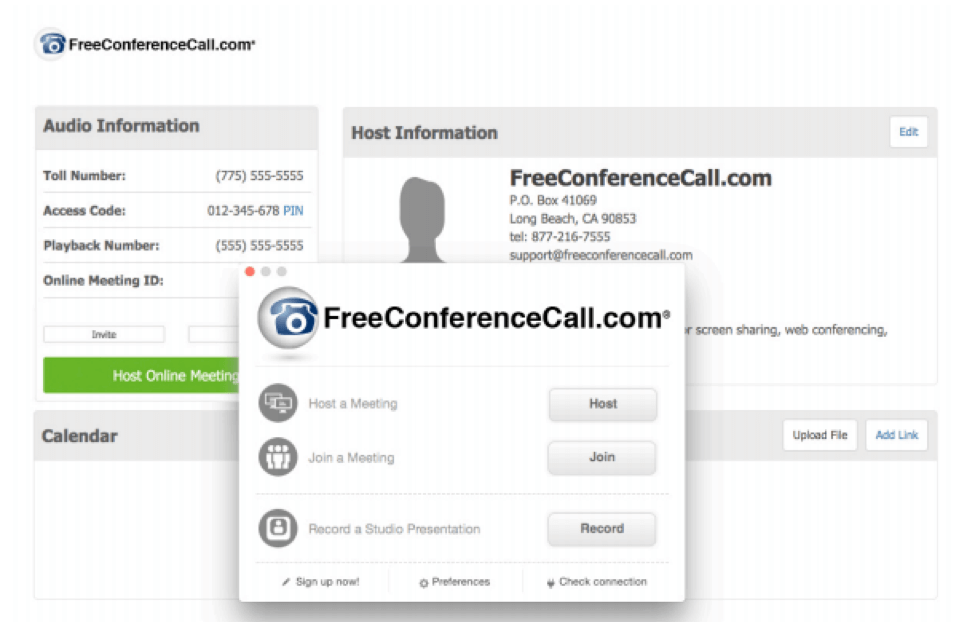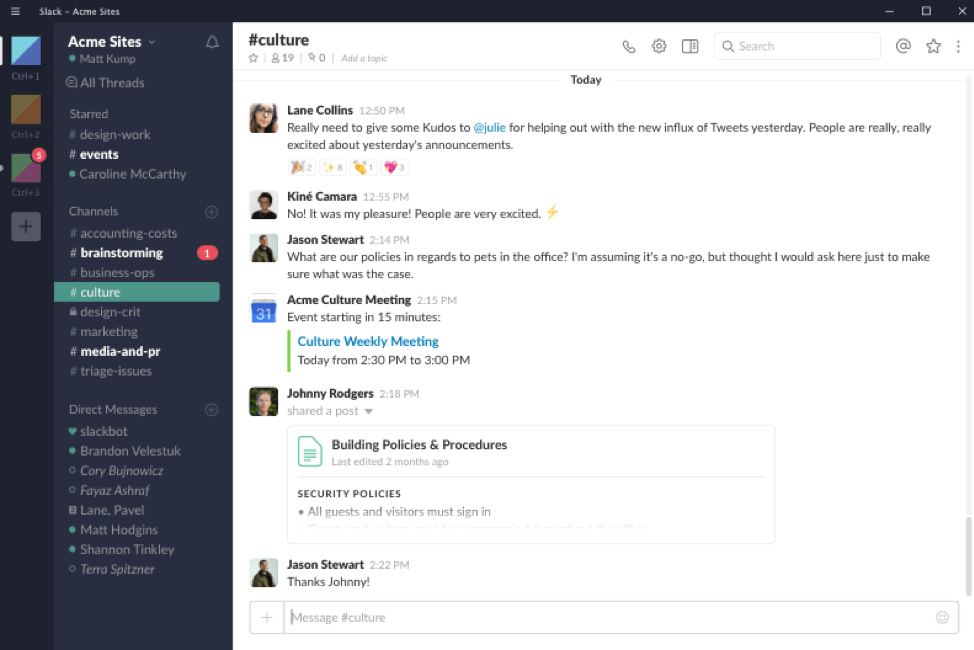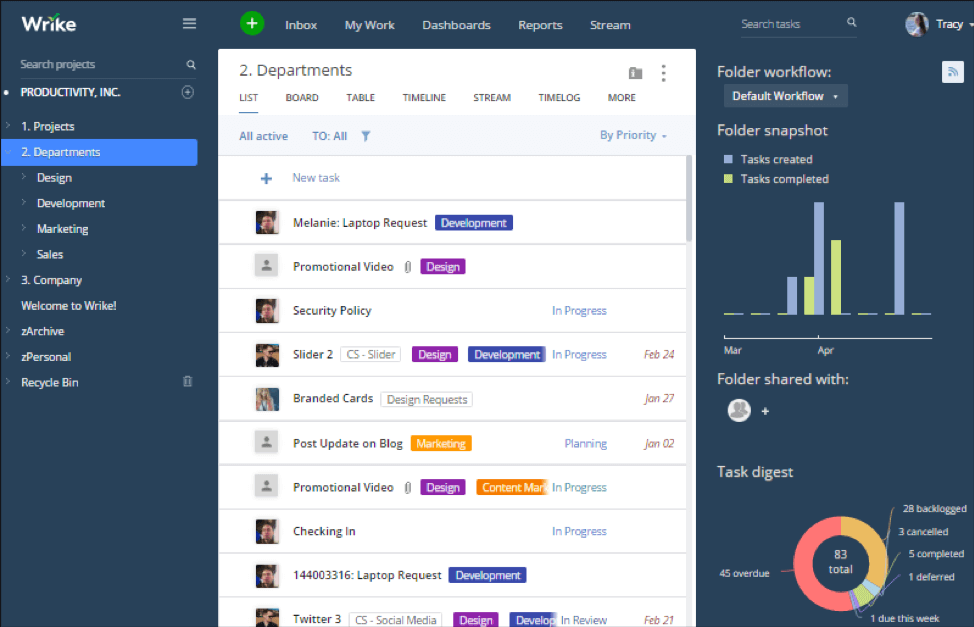Good communication is the backbone of any successful business. In fact, a study from Willis Towers Watson found that companies with effective communication are three and a half times more likely to outperform their peers.
Today, there are a wide variety of tools and screen sharing sites that claim to help businesses improve their internal communications, but only a select few deliver on that promise.
These are the four best internal communications tools for businesses:
1. For meetings, webinars and conferences: FreeConferenceCall.com
2. For quick and easy chatting: Slack
3. For document sharing: Google Drive
4. For project management: Wrike
Let’s find out more about internal communications, why it’s important and how the right tools can improve your company’s internal communications.
What Is “Internal Communications?”
Simply put, internal communications refers to effective communication within an organization. What it doesn’t refer to is “water cooler talk,” or non-business-related conversation — internal communications is all about how people within an organization actively establish a shared understanding of a common goal and work together to achieve that goal.
This includes communication between all members of an organization, not just between members of the same team. If managers have no idea why executives make the decisions they do, then it will become exponentially more difficult for everyone to make a unified effort toward success.
Why Do Internal Communications Matter?
No matter what industry or sector a company operates in, their common goal includes productivity and efficiency. After all, productivity and efficiency are key to generating revenue, which is something that no company can survive without.
Although many other factors affect a company’s short- and long-term accomplishments, it’s undeniable that internal communications is a critical element of success.
This isn’t just a theory, either — companies suffer very real losses as a result of poor communication: A 2017 Webtorials study found that companies lost nearly $11,000 per employee per year as a direct result of poor communication.
Plus, money isn’t all that’s on the line: According to a survey from Fierce, 86 percent of employees blame workplace failures on a lack of collaboration, while an overwhelming 97 percent believes that lack of alignment within a team directly impacts the outcome of tasks and projects.
The Best Internal Communications Tools for Businesses
Now that we’ve explored the importance of internal communications, let’s take a look at the top four internal communications tools.
1. FreeConferenceCall.com: Free Online Conferencing and Meeting

Meetings play an invaluable role in a company’s internal communications efficacy. Yet, something about traditional meetings just isn’t working — according to a survey published in the “European Journal of Work and Organizational Psychology,” U.S. companies lose an astounding $37 billion per year due to unproductive meetings.
Fortunately, meeting tools like FreeConferenceCall.com, join.me and GoToMeeting help to solve this problem by giving businesses the option to hold meetings, video conferences, webinars, audio calls and more online.
What sets FreeConferenceCall.com apart from the others is that it’s completely free — FreeConferenceCall.com offers a complete suite of online meeting services for absolutely no cost. Paid plans are available as well, which offer enhanced features and greater control.
Free audio conferencing features include:
- Recording with playback
- Web controls
- Service to 64 countries
- Transcribed keywords
- Phone keypad commands
- Outlook and Google Calendar integration
Free video conferencing and webinar features include:
- Screen sharing
- Up to 1,000 participants
- Up to five video feeds
- Remote desktop tool
- Recording with playback
- Studio presentation
- Moderated chat box
Free meeting wall features include:
- Custom URL, profile photo, company logo and description
- Radio features
- Chat functionality
- Document and link sharing
- History and recordings
- Broadcaster tool for easy sharing of pre-recorded content
Optional paid plans include features such as:
- Up to 1 gigabyte of free storage
- Custom greeting and hold music
- Admin portal
- User management
- Activity summaries
- API access
- Dedicated global number sets
2. Slack: Cloud-Based Communication

Slack broadly defines itself as “a place where your team comes together to collaborate.” In practice, it consists of multiple custom “channels” in which people from all levels of a company can talk to each other in a chat room.
Slack charges users based on three plans: free, Standard and Plus. The Slack Standard plan costs $6.67 per active user per month, while the Slack Plus plan costs $12.50 per active user per month.
Its free features include:
- Customizable channels
- Instant message sharing
- Direct messages
- File sharing
- Search function of up to 10,000 messages
- Up to 10 apps and integrations
- One-to-one video calls
Slack Standard plan features include:
- Search function of entire message archive
- Unlimited apps
- Custom profiles
- Group voice calls
- Group video calls with screen sharing
- Guest accounts and shared channels
Slack Plus plan features include:
- Guaranteed 99.99 percent uptime service level agreement (SLA)
- Data exports
- Corporate exports for all messages
3. Google Drive: Cloud Storage and Syncing

Google Drive is a cloud storage and file backup service that allows teams to quickly and easily upload and share a variety of file types. This means that you’ll be able to stop sending Word documents over individual emails and start uploading them all in one place, collaborating on editing projects in real time and easily mentioning colleagues using their email address.
Google Drive is free, but its upgraded version — Google One — costs $1.99 per month for 100 gigabytes of storage or $2.99 per month for 200 gigabytes.
Its free features include:
- Fifteen gigabytes of storage
- Ability to store documents, photos, videos, presentations, PDFs, spreadsheets, Microsoft Office files and more
- Native integration with Google’s own Docs, Sheets and Slides apps
- Offline functionality
- Built-in Gmail attachment saving
- Customizable viewing, commenting and editing privilegesGoogle One features include:
- Increased storage space
- Access to Google experts
- Automatic backup and syncing
- Uncompressed photos and videos
4. Wrike: Online Project Management

Wrike is real-time project management software that’s designed to keep everyone up to date on all projects and tasks at all times. Comparable tools include Asana, Trello and Podio, all of which have their own set of useful features.
Like Slack, Wrike charges users based on plans. In addition to its free plan, it offers a Professional plan for $9.80 per user per month and a Business plan for $24.80 per user per month, as well as more specialized Marketing and Enterprise plans.
Its free features include:
- Up to five users
- Task management
- Real-time activity stream
- File sharing, including online editing and uploading
- Integrations with Google Drive, Dropbox, Box and other common apps
- Two gigabytes of storage spaceIts Professional plan features include:
- Up to 15 users
- Task and subtask management
- Gantt chart to help visualize tasks
- Advanced integrations with programs like Microsoft Excel
- Shareable dashboards
- Five gigabytes of storage space
* Fifteen gigabytes of video uploads per monthIts Business plan features include: - Custom fields and workflows
- Shared real-time reports with schedule notifications
- Report templates
- Calendars
- Resource management
- Time tracking
- Graphical analytics
- Fifty gigabytes of storage space
- Fifteen gigabytes of video uploads per monthWith any of these four tools under your belt, you’ll have the chance to significantly improve the efficiency and efficacy of your company’s internal communications, which in turn may result in increased productivity, boosted morale and a better bottom line.To start upgrading your company’s internal communications now, learn more about FreeConferenceCall.com’s completely free suite of conferencing, meeting and collaboration services.


